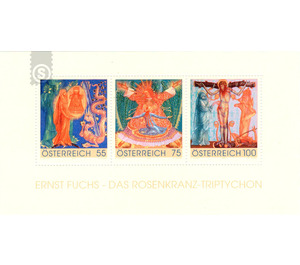Ernst Fuchs Rosary Triptych - Austria / II. Republic of Austria 2009
Theme: Architecture
| Country | Austria / II. Republic of Austria |
| Issue Date | 2009 |
| Edition Issued | 750,000 |
| Item Type | Block |
| Chronological Chapter | OOS-OE2 |
| Chronological Issue Number | Block 54 |
| SID | 536070 |
| In 50 Wishlists | |
The Rosary triptych in the parish church of Vienna-Hetzendorf, created by the academic painter Ernst Fuchs between 1958 and 1959, is a unique work of art in terms of artistic content, masterly execution and religious engagement with the theme of rosary secrets. Fuchs, a major representative of the so-called "Viennese School of Fantastic Realism", received the baptism of a Jewish family in 1942 and took a deep look at his faith. This struggle was also expressed in intensive discussions and discussions between the then pastor of Hetzendorf, Prelate Joseph Ernst Mayer, and the artist. With his triptych, Prof. Ernst Fuchs deliberately wanted to dissolve the conflict between Judaism and Christianity and to encourage a dialogue on this subject. The first painting - "The Glorious Rosary" - was erected as early as 1958 in the apse of the newly redesigned interior of the church. The other two - "The Joyful Rosary" and "The Painful Rosary" - followed in 1960; at Christmas of the same year the triptych was complete. It was deliberately placed behind the Sessio, so that it optically separated the choir room from the rest of the church as a weekday parish. Experts and the press were enthusiastic, but in a series of letters to the parish, helpless incomprehension and hateful rejection showed. In September 1979, the pictures were finally torn down and severely damaged by numerous long cuts and wrinkles and creases. The color of the pictures was partially rubbed off, the gilding was destroyed and the painting surface peeled off. Thanks to the commitment of the parish and the skills of the restorer Donald Corcoran, the painting was restored in years of detail. The unique thing about this restoration is probably that the transparency of the parchment was preserved despite gluing and in this way the light from the back makes the images shine. Since April 1999, the monumental work now graces the parish church of Hetzendorf with dimensions of three by three meters. The soberly designed, white painted church is the ideal space for the painting dar. Ernst Fuchs' great work in turn gives the parish in an aesthetically simple way its well-known name: Rosary Church. In his autobiographical work "Fuchs on Ernst Fuchs", the artist once wrote: "I prayed, meditated, got to know my church ... This was my job: The image of the Messiah, the icon of Jesus of Nazareth."


